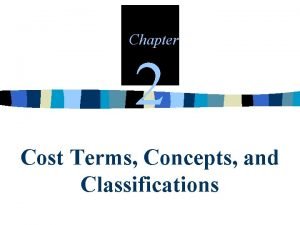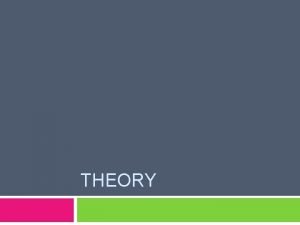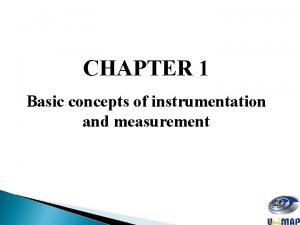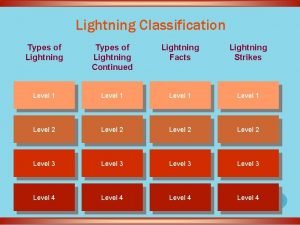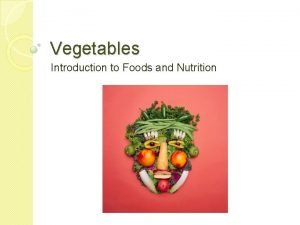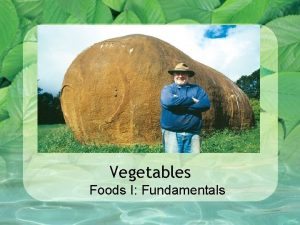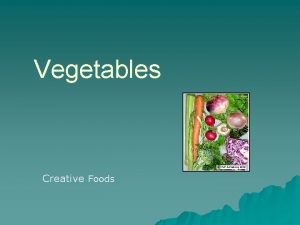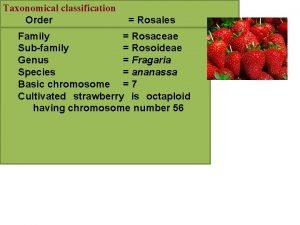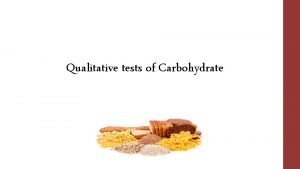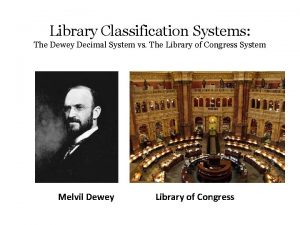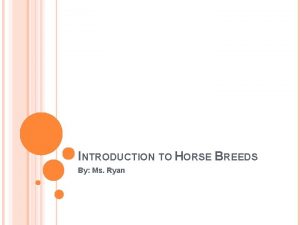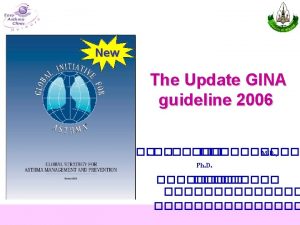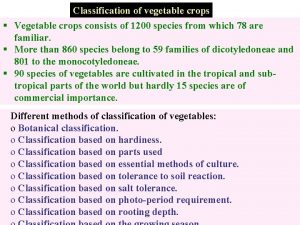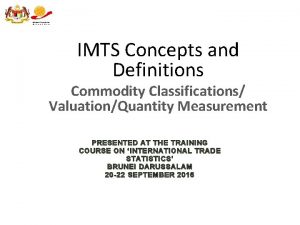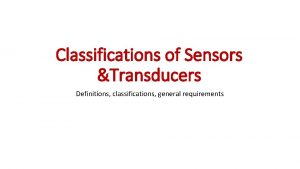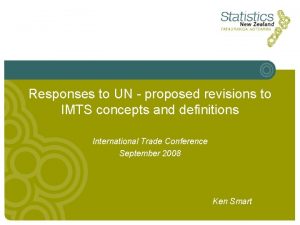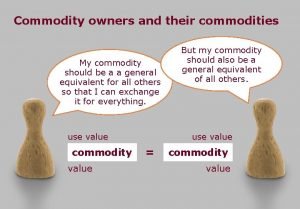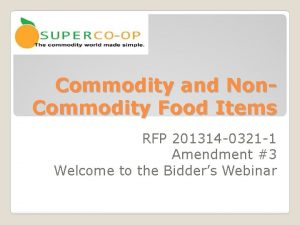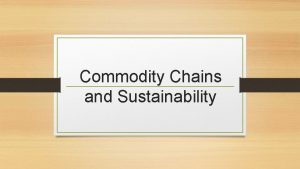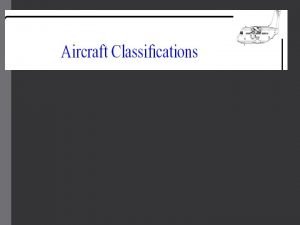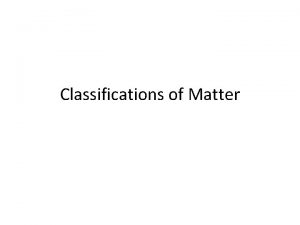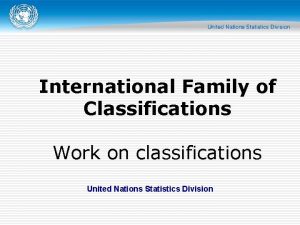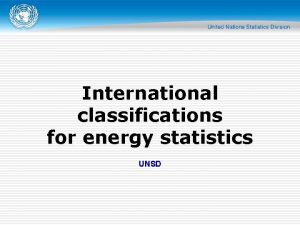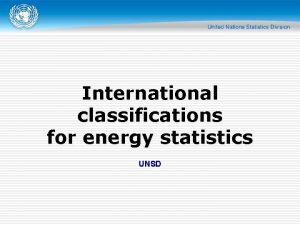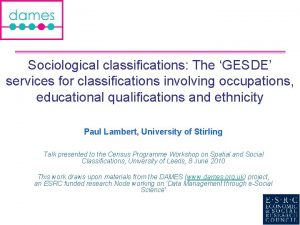IMTS Concepts and Definitions Commodity Classifications ValuationQuantity Measurement





















- Slides: 21

IMTS Concepts and Definitions Commodity Classifications/ Valuation/Quantity Measurement PRESENTED AT THE TRAINING COURSE ON ‘INTERNATIONAL TRADE STATISTICS’ BRUNEI DARUSSALAM 20 -22 SEPTEMBER 2016

Outline 1. Commodity Classification 2. Valuation 3. Quantity Measurement

Classifications 1. Commodity classifications ISIC: International Standard Industrial Classification of All Economic Activities CPC: Central Product Classification SITC: Standard International trade Classification BEC: Broad Economic Classification HS: Harmonized Commodity Description and Coding System (Harmonised System )

Classifications 1. Commodity classifications IMTS 2010 Recommendations: • Use HS for the collection, compilation and dissemination of IMTS • In addition to HS, use SITC for the dissemination and the analysis of IMTS according to users requirements IMTS 2010 Encouragement: • Use the most current version of HS Correspondence tables: describe the relationship between different classifications or different versions of the same classification by providing the relationship between the elements (codes) of the two classifications at the detailed level (see UNSD website).

Classifications 1. Commodity classifications Harmonised System: • The latest version of the HS is known as HS 2012 and came into force on 1 st January 2012. This is the fourth major revision of the HS developed by the World Customs Organisation, since the system was adopted in 1983 and implemented in 1988. Previous revisions were in 1996, 2002, and 2007. • The HS follows a hierarchical structure, comprising 21 sections, 98 chapters (2 digit), 1231 headings (4 digit), and 5, 212 sub-headings (6 digit). This structure is generally broken down at more detailed level at national level or at Customs Union level. • The amendments take in account the technological progress and changes in trade patterns, clarify the text to ensure uniform application of HS, and provide a legal basis for decisions taken by the Harmonized System Committee.

HS and AHTN STRUCTURE 2002 2004 2007 2012 Sections 21 21 21 Chapters 96 96 97 4 -digit headings 1, 244 1, 221 1221 6 -digit subheadings 5, 224 5, 052 5052 HS (9 -digit) 18, 593 10, 404 9, 450 12, 339 12, 324 AHTN (10 -Digit) 9/16/2021 12, 181 (introduced in 2004) 6

HS STRUCTURE CHAPTER 4 -DIGIT HEADING 85 8540 Electrical machinery and equipment and parts thereof; sound recorders and reproducers, television image and sound recorders and reproducers, and parts and accessories of such articles 8541 8542 8543 8544 Insulated wire, cable and other insulated electric conductors, whether or not fitted with connectors; optical fibre cables, made up of individually sheathed fibres, whether or not assembled with electric conductors or fitted with connectors. 6 -DIGIT SUBHEADING 854411, 854420, 854430, 854442, 854449, 854460, 854470 Co-axial cable and other co-axial electric conductors 9 -DIGIT TARIFF CODE 9/16/2021 854420100 • Insulated with rubber 854420200 • Insulated with plastics 854420900 • Other 7

Classifications 1. Commodity classifications SITC (Standard International Trade Classification): • Created in 1950 to report and analyse international trade statistics • SITC revision 4 issued by United Nations in 2006 • It contains 3, 993 basic headings and subheadings, which are assembled in 262 groups, 67 divisions and 10 sections BEC (Broad Economic Categories) Devised by UNSD for summarization of trade data by large economic classes of commodities • Three basic classes of goods in SNA: capital goods, intermediate goods and consumption goods. • BEC has 19 basic categories that can be aggregated to approximate these three basic classes of goods, thus permitting trade statistics to be considered jointly with other sets of general economic statistics - such as national accounts and industrial statistics - for national, regional or global economic analysis

SITC STRUCTURE SECTION (1 -DIGIT) • 0 • Food and Live Animals • Total section: 10 9/16/2021 DIVISION (2 -DIGIT) • 05 • Vegetables and Fruit • Total Division: 67 GROUP (3 -DIGIT) • 057 • Fruit and nuts (not including oil nuts), fresh or dried • Num. of groups: 262 SUB-GROUP (4 -DIGIT) • 0571 • Oranges, mandarins , clementin e and similar citrus hybrids, fresh or dried • Num. of subgroups: 1, 023 BASIC HEADING (5 -DIGIT) • 05711 • Oranges, fresh or dried • Num. of basic headings: 2, 970 SITC (9 -DIGIT) • 057110100 • Oranges, fresh or dried • Total num. : 16, 345 9

Classifications Product classification CPC (Central Product Classification): • The Central Product Classification (CPC) originated from initiatives in the early 1970 s to harmonize international classifications. The new classification was intended to cover both goods and services (products) and would use the detailed subheadings of the Harmonized System as building blocks for the part dealing with transportable goods. • In 2008, the work on CPC, Version 2. 0 was completed. This version of CPC is divided into 10 sections, 71 divisions, 324 groups, 1, 267 classes and 2, 738 subclasses

Classifications Industry classification ISIC (International Standard Industrial Classification of All Economic Activities): • Unlike HS, SITC, BEC and CPC that are product classifications, ISIC is the international reference classification of productive activities. • Its main purpose is to provide a set of activity categories that can be utilized for the collection and reporting of statistics according to such activities. • Correspondence table between HS, SITC, CPC and ISIC can be established • This correspondence may be useful when analyzing trade flows by activity categories… • However, alternative approach by identifying the activity of the trader, should be given preference

CORRESPONDENCE TABLES HS 6 -digit CPC 9/16/2021 • SITC (5 -digit) • BEC • CPC • ISIC 12

CORRESPONDENCE TABLES (cont. ) HS 854420100 SITC (UN) 773120100 Coaxial cable and other coaxial conductors 854420200 773120200 854420900 773120900 847170100 752700010 Storage unit 847170200 752700030 847170300 752700070 080510100 057110100 Oranges, fresh or dried 080510200 9/16/2021 057110200 BEC (UN) CPC (UN) ISIC (UN) 22 46320 2732 (n: 1) 41 45271 2620 (n: 1) -Industrial supplies not elsewhere specified -- Processed (Intermediate Goods) -Capital goods (except transport equipment) & parts & accessories thereof --Parts and accessories (Intermediate Goods) 112 -Food and beverages --Primary ---Mainly for household consumption (Consumption Goods) Coaxial cable and other coaxial electric conductors Fixed media storage units Manufacture of other electronic and electric wires and cables Manufacture of computers and peripheral equipment 45272 Removable media storage units 01323 Oranges 0123 (n: 1) Growing of citrus fruits 21419 1030 (n: 1) Other dried fruit, Processing and preserving of fruit and vegetables n. e. c 13

Summary UN recommendations 2. Valuation It is recommended that: • for all goods covered in international merchandise trade statistics whether sold, exchanged or provided without payment, a statistical value is recorded following the specific rules as defined below… • the customs value, when established in compliance with the WTO Agreement on Customs Valuation, should form the basis for the statistical value • countries adopt the WTO Agreement on Customs Valuation as the basis for valuation of their international merchandise trade for statistical purposes (whether a country is a WTO member or not). This recommendation for determining the statistical value applies to both imports and exports. The WTO Agreement on Customs Valuation adopts the transaction value (the price actually paid or payable for goods including some adjustments) as the customs value of imported goods, provided that certain conditions for a fair, uniform and neutral valuation are met (IMTS 2010 Annex D) /35

Summary UN recommendations 4. Valuation To promote the comparability of international merchandise trade statistics and taking into account the commercial and data reporting practices of the majority of countries and analytical needs, it is recommended that: (a) The statistical value of exported goods be an FOB-type value; (b) The statistical value of imported goods be a CIF-type value; • • • /35 However, countries are encouraged to compile FOB-type value of imported goods as supplementary information Countries which compile only CIF-type values of imports are encouraged to compile separately data for freight and insurance, at the most detailed commodity and partner level possible…

Summary UN recommendations 2. Valuation – Specific cases Valuation of special categories of goods • Media, whether or not recorded: to be valued at their full transaction value (i. e. not at the value of the empty diskettes or CD-ROMs), except customised software • Goods under financial lease: Goods which are part of a financial lease should be recorded using a value equivalent to the price of the goods if offered for sale • Goods for processing with or without change of ownership: Goods for processing should always be valued at their full (gross) value • Returned goods: if identifiable, are to be valued as at the initial transaction. /35

Summary UN recommendations 2. Valuation – Specific cases Valuation of special categories of goods International transaction in goods that may not require goods valuation by parties involved: • • • trade and barter agreements based on quantities without stated prices food and other humanitarian aid goods on consignment goods for processing migrants' effects cross-border movements of unsold articles and gifts and donations made by private agencies or persons. In these cases, following the general recommendation, the value of the goods should be established in accordance with the WTO Agreement on Customs Valuation (including the use of transaction value of identical or similar goods, or a computed value) /35

Summary UN recommendations 3. Quantity measurement Quantity information is needed for various policy and analytical purposes including: • • • the planning of transport infrastructure, the compilation of energy, agricultural and other commodity balances, the assessment of the impact of international trade on environment, the verification of trade values the construction of trade index numbers In 1995, WCO adopted a recommendation on the use of standard units of quantity to facilitate the collection, comparison and analysis of international statistics based on the Harmonized System The standard units of quantity are specified for each HS 6 -digit subheading /35

Summary UN recommendations 3. Quantity measurement WCO standard units of quantity • Weight: kilograms (kg), carat (carat) • Length: metres (m) • Area: square metres (m 2) • Volume: cubic metres (m 3), litres (l) • Electrical power: 1, 000 kilowatt-hours, • Number (units): pieces/items (u), pairs (2 u), dozens (12 u), thousands of pieces/items (1, 000 u), packs (u(set/pack) /35

Summary UN recommendations 3. Quantity measurement Recommendations: • • /35 It is recommended that countries collect or estimate, validate and report quantity information in the WCO standard units of quantity and in net weight on all trade transactions Apply the same quantity units within one sub-heading (6 -digit HS). If not, provide a clear description Where non-standard units are used, provide conversion factors to the standard units Identify estimated quantities, as deemed necessary and provide information of methodology used

21
 Cost terms concepts and classifications
Cost terms concepts and classifications Examples of reciprocal determinism
Examples of reciprocal determinism Basic concepts of instrumentation
Basic concepts of instrumentation Types of lightning
Types of lightning Classification of tools used to assemble wood
Classification of tools used to assemble wood Vegetable classifications
Vegetable classifications 8 classifications of vegetables
8 classifications of vegetables Mildly flavored vegetables cooking methods
Mildly flavored vegetables cooking methods Rosales
Rosales Nightshade organism classifications
Nightshade organism classifications 2 classification of shellfish
2 classification of shellfish Classifications of oblique triangles
Classifications of oblique triangles Flis reportable events
Flis reportable events Molisch test reaction
Molisch test reaction Library of congress vs dewey
Library of congress vs dewey Draft horse organism classifications
Draft horse organism classifications Unsd classifications
Unsd classifications Mnemonic for fire extinguisher types
Mnemonic for fire extinguisher types Data center classifications
Data center classifications How to classify asthma
How to classify asthma All classification levels
All classification levels Botanical classification of vegetable
Botanical classification of vegetable
